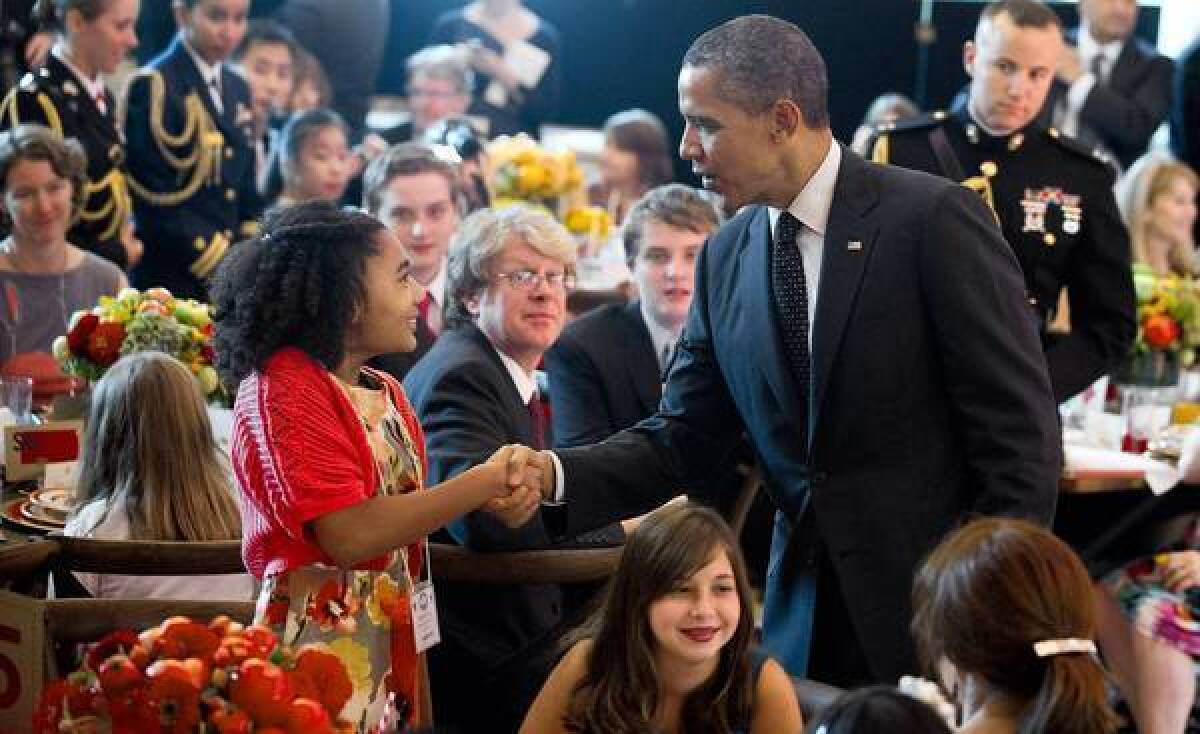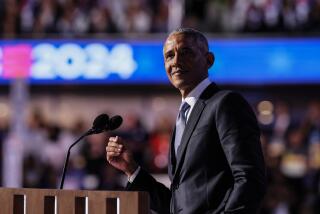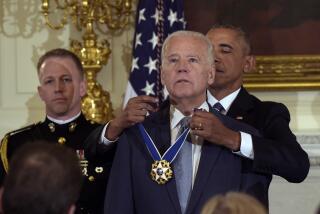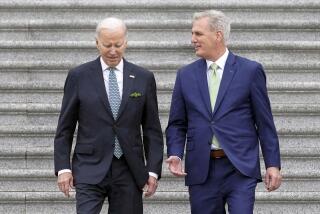Obama faces deep division

CHARLOTTE, N.C. — It was the promise that first brought Barack Obama to national attention, and the one that his presidency has most conspicuously been unable to fulfill — the hope of national unity.
“There’s not a liberal America and a conservative America; there’s the United States of America,” Obama, then a candidate for the U.S. Senate and relatively unknown outside Illinois, declared in his keynote speech to the Democratic convention in 2004.
That speech — and the image it created of a political leader with potential to reach across partisan bounds — formed the springboard that helped Obama make the improbable leap from freshman senator to the Oval Office just four years later. Against the backdrop of deep partisan division during George W. Bush’s presidency, many voters saw a potential healer in the young, biracial candidate who had spent limited time as a member of the deeply unpopular Washington political elite.
Today, as he prepares to accept his party’s nomination for a second term, 3 1/2 years in office have ground away much of that nonpartisan aura, leaving behind a deeply polarized view of the nation’s 44th president.
Many Republicans denounce Obama as a “socialist.” They express fears that he seeks to radically transform the country. Polls repeatedly have shown Republican voters expressing pessimism about the country’s future and worrying that the U.S. has been set on a path toward decline.
At the same time, despite complaints from the left about issues as diverse as the war in Afghanistan, which he has pursued, and efforts to cap greenhouse gases, which he has not, Obama has retained strong support within his own party.
As measured by Gallup, his job approval during most of his tenure among members of his own party has surpassed that of any Democratic president since John F. Kennedy.
The partisan gap in views of Obama is among the largest in modern history, only exceeded — and then just barely — by the division over Bush.
Republicans have sought to exploit a shift in Obama’s public image. His rival, Mitt Romney, seldom lets a speech go by without criticizing Obama as a “divider.”
Ironically, however, if Obama wins a second term, a shift toward greater partisanship that began a year ago may well prove the single most important reason why — the key to his recovery from near-collapse last summer.
Obama portrays his failure to bridge the partisan gap as among his biggest frustrations in office.
“I haven’t been able to change the atmosphere here in Washington to reflect the decency and common sense of ordinary people — Democrats, Republicans and independents — who I think just want to see their leadership solve problems,” he said earlier this summer in an interview with CBS correspondent Charlie Rose. “And, you know, there’s enough blame to go around for that.
“I think there is no doubt that I underestimated the degree to which in this town politics trumps problem-solving,” Obama added.
As a political leader whose desire to build bridges across the political divide at least appears genuine, Obama had the bad luck to come to office when that divide — both in Washington and among voters nationwide — yawned wider than at any time since before World War II.
Ever since the late 1980s, the percentage of Americans who call themselves strong partisans has risen, accelerating over the last decade. Republicans have moved several steps to the right on average, while Democrats have moved a somewhat smaller degree to the left.
That gap posed a fundamental problem for the new administration from its beginning, said a longtime Democratic strategist who spoke on condition of anonymity to avoid straining his close ties to the White House. In his 2008 campaign, the strategist said, Obama made two overarching promises: On the one hand, he pledged to create a new kind of politics; on the other, to enact major structural reforms in healthcare, the financial markets and the energy industry.
“He found out you couldn’t do both,” the strategist said.
Obama’s legislative goals — a government guarantee of health coverage, stronger regulation of the financial industry, new environmental controls to fight global warming — all would expand government. Pushing those ideas, even in forms that some liberals found too weak, clashed directly with the intensifying desire of Republican voters to roll government back. That made the bipartisan politics Obama had spoken of all but impossible.
Republican leaders, meanwhile, eagerly grabbed opportunities to block Obama’s path — frustrating the new administration’s plans while highlighting the differences between the parties.
All that took a toll.
Shortly after his inauguration, a Fox News poll found Americans evenly divided over whether Obama would bring about “real change” in Washington or “more of the same.” By one year into his administration, “more of the same” was prevailing nearly 2 to 1.
White House officials fume at the course the Republicans took.
“Republicans made a strategic decision” at the beginning of the new administration that “their path to regaining power was to block the president at every path,” said White House communications director Dan Pfeiffer.
White House aides cite Senate Republican leader Mitch McConnell’s public declaration in an Oct. 2010 interview with National Journal that making Obama a one-term president was the GOP’s top priority. And, they say, Republican legislators proved during last summer’s clash over the federal debt ceiling that they would go to unprecedented lengths to try to thwart Obama’s plans.
Republican legislators, of course, see the matter differently. They point to Obama’s lack of personal relations with members of Congress and the manner in which early fights exacerbated already tense relations between the parties in Congress.
“They got off on the wrong foot,” said Sen. Olympia J. Snowe, one of a small number of Republican senators who was sometimes willing to engage with the White House on legislative matters.
Obama’s “attitude in dealing with the Senate has made it enormously difficult” to reach agreements, said Tennessee Republican Sen. Lamar Alexander. “They have no relationship with the Republican caucus.”
White House allies concede that Obama has limited patience for the ego-stroking and bonhomie that previous presidents have used to try to persuade lawmakers. But outside analysts express skepticism that even the kind of personal wooing that Lyndon B. Johnson employed would do much good half a century later in an era in which legislators and voters are far more deeply divided along partisan lines.
“The only thing he could have done differently would have required him to make even bigger concessions on policy to Republicans,” said Emory University political scientist Alan Abramowitz. “This isn’t about social niceties — inviting Republicans to the White House, for example.”
The kind of concessions needed “would have alienated core Democratic constituencies,” he added. “That’s the trade-off.”
From the beginning, Obama guarded against that sort of division within his party. He disappointed liberals on some policy issues, but kept focused on key party priorities. And despite periodic disgruntlement on the left, he never faced the kind of challenge within his party that scuttled Jimmy Carter’s presidency in 1980.
The exception came last summer. Amid the protracted efforts to reach a “grand bargain” with Republicans over the government’s long-term deficit and the standoff over the federal debt ceiling, assessments of Obama’s job approval began to plunge. Among Democrats, his approval ratings dropped to a level that would have made reelection untenable.
At that point, the White House began a significant shift of strategy. Keeping Washington at arm’s length, using Congress as a foil and employing executive action much more often, Obama began looking for ways to confront Republicans on a more aggressively partisan basis.
“It was clear that the only possible path” was for the president to “take his message to the country,” Pfeiffer said.
The strategy has revived Obama’s fortunes — at least enough to guarantee a close and extremely stable race.
In political terms, Obama and his aides placed a bet that was the mirror image of the one Bush had wagered eight years earlier. In 2004, Bush and his strategists believed that in a head-to-head race between the core supporters of the two parties, Republicans would come out ahead. Today, because of the growth of the minority population and the Democratic leanings of younger voters, Obama’s team believes their party’s base is the larger.
If they prove correct, their success with a more partisan tone over the last year will influence White House thinking about what Obama might do in a second term.
Senior aides say Obama continues to want the sort of bargain that eluded him a year ago — a trade in which Democrats would accept long-term cuts in social programs and Republicans would accept new taxes. That would constitute a significant victory of the sort that might pull at least some centrist voters into his camp, White House strategists hope.
But they describe a stonier path than the one Obama appeared to envision in his 2004 address. Just as Republicans sought to win a knockout victory that year — and again in 2010 — that would avoid the necessity of fundamental compromise, so, too, the White House wants a bargain, but on its own terms.
As they talk about their hope that Obama’s reelection might cause Republicans to cooperate with the White House, officials from the president on down use a consistent image — a “fever breaking.” The metaphor is not a charitable one, implying as it does that the other side is gripped by a form of delusion, and that progress will come about when the other side changes.
It is a harder-edged and less lofty sentiment, perhaps, than the “one America” theme Obama expressed from the convention podium eight years ago. But in a deeply divided nation, it just may prove the ticket to success.
More to Read
Get the L.A. Times Politics newsletter
Deeply reported insights into legislation, politics and policy from Sacramento, Washington and beyond. In your inbox three times per week.
You may occasionally receive promotional content from the Los Angeles Times.











